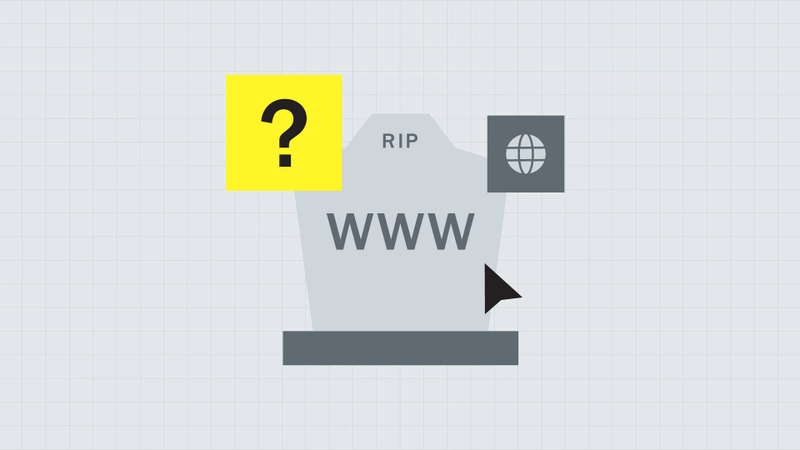Every few years there seems to be a need to ‘go again’ with your website. If you’re anything like us, you’ll need more than one hand to count the number of sites that you have built for your business. If I listen hard enough, I can hear the echoes of ‘longer shelf life’ and ‘higher ROI’ from marketing teams the world over. I shouldn’t say this, but I will – I am really happy to have put our recent site rebuild project in the rear-view mirror. It’s a big undertaking, a big time investment to have to roll around so often.
As we launch our new website for our agency, I find myself wistfully asking myself – is this the last website we will ever build for ourselves? Is AI filling the gap as we speak? Personally I don’t think we’re there yet. I don’t think websites as we know them are dead, but I do think things are evolving. Our audiences may not only be human anymore, but websites are still part of the mix.
A quick trip down memory lane
Imagine this. It’s the early 2000’s, Super Rugby still had 12 teams, ‘just Google it’ was not in our vocabulary and having a website was a novelty. You probably had your first website built by someone like me, a nerd with Macromedia Dreamweaver(!!!) and too much time on their hands.
Back then all you had to worry about was whether you should build your website for 800x600 or 1024x768 screen resolution and how many HTML tables you could nest before you broke your Netscape Navigator. I don’t think anyone was really thinking that a website could drive true value for their business unless your name was Pierre Omidyar, Peter Thiel or Jeff Bezos. And if you are reading this and were building sites before the 2000’s – we’re not worthy.
Major ‘website rebuild’ moments include the advent of Content Management Systems like WordPress (2003-ish), Mobile responsive design (first coined in 2010), and Google’s famous Panda algorithm update (2011). To web nerds like myself, each of these has rich nuance but for most businesses, these were evolutions, not revolutions. In the last 10 years there really hasn’t been anything to ‘break the internet’. Is that all changing?
AI is shifting how we search online
We have spent the last 20 years relying on the 10 blue links served up by Google search engine results, but it is undeniable that AI is shifting this landscape. Whilst Google is still the dominant force with a reported 5 trillion annual searches, LLMs like ChatGPT have eye-watering growth trends. Earlier this year ChatGPT had up to 500 million weekly users. Unless you are living under a rock, you know Google has made significant changes with its “AI mode”. This all signals a seismic shift in how people are seeking and consuming information online.
As adoption of AI for search continues to scale up, it paints an undeniable truth. Traffic to your website is destined to decline. But on the converse, for businesses that are focusing on building their presence in AI (AIO, GEO, AEO, or whatever we are calling it), branded search should increase. Over time, we can consider traffic far more “qualified”, increasing conversion rates if you’re optimising your website accordingly.
And what about e-commerce? How ‘top of funnel’ can we consider ChatGPT, given that it can serve you product listings and source reviews from multiple sources? That is exactly what is happening as of April this year, meaning you can browse, research and do all but check out without visiting retailer’s websites. So the e-commerce website is still involved in the process…for now. OpenAI is actively developing a check-out system as we speak. That is a big deal – watch this space.
Native AI browsers are just around the corner
Just before the change fatigue sets in, here come AI browsers. Comet by Perplexity is currently in its invite-only phase, and although not the only AI browser out there, it signals further integration of AI into the web browsing experience. And what have we got to look forward to feature-wise? In-browser AI assistants summarise website content and even complete actions like click, navigate and fill in forms. Voice interactions and automation of multi-step check-out tools mean you can’t assume that the traditional “point, click, point, click” or “tap tap swipe” user interactions are how visitors will be interacting with your website.
It’s the ‘fast fashion’ era of website development
It’s so easy to set up a website these days. Who hasn’t heard of WIX or Squarespace? Webflow or Framer? These are all good SaaS systems that lower the barrier to getting online. Where applicable, we use them ourselves. They just get the job done when you need something up fast.
The irony of this is to compete online you need to take care of the fundamentals really well. And some of those fundamentals are more than skin deep. Site speed, strong mobile UX, responsiveness, schema tagging, authoritative content - all things that contribute to a healthy web presence. I’m all for lowering the barrier for digital entry, but don’t fool yourself into thinking you can ‘vibe code’ your way to the top. Especially with AI heaping more complexity on top.
Is it the end of websites as we know them? TBD.
Is this a website ‘paradigm shift’? It’s pretty darn huge. I’d say it’s the largest potential disruption we have seen in quite some time. But for now I don’t see websites going away - simply evolving. Immediate focuses for me are on structure and content for both human and AI consumption and ensuring any B2B site (as always) is built for ‘bottom of funnel’ conversion.
And if you’re still on your old 2010’s or earlier site, now might be a good time to catch up!



